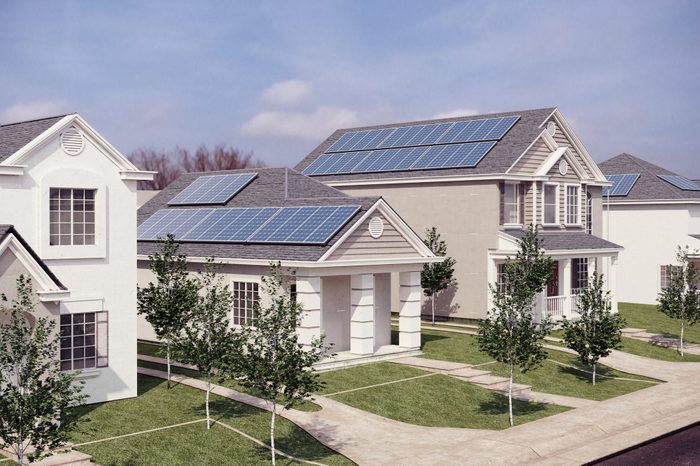How Much Do Solar Panels Cost?

This often-asked question doesn't have a simple answer, but our explanation of the factors that determine solar panel cost can help.
My partner and I began our dive into solar power for two reasons. We want to build a workshop in a rural area without access to grid power, and my mom keeps asking if she should install solar panels on her house in the city.
These two scenarios have different costs and installation complexities. But the good news is, both are DIYable if you have some electrical knowledge. And now, there are also tax incentives available that can significantly reduce the cost of installing solar power systems in your home that were approved as part of the Inflation Reduction Act of 2022. Here’s what we’ve learned about what to expect in each situation.
On This Page
What Is a Solar Panel?
A solar panel collects energy (photons) from sunlight, which can be converted into electricity. Each solar panel contains multiple photovoltaic cells, usually set under glass and contained within a metal frame.
Solar panels create direct electrical current (DC), which an inverter converts into alternating electrical current (AC) that systems in your house can use. Solar panels are only one part of a solar energy system, along with inverters, charge controllers, electrical panels and meters, racking and storage batteries.
Types of Solar Energy Systems
There are three kinds of residential solar energy systems:
- Grid tie: The most affordable type. This collects solar energy and puts it back into the grid. You’ll save money on power bills, but your power will still go out if the grid goes down because there’s no battery storage.
- Off-grid: This means your house is not tied into any utility company electric lines, but instead works as its own power generation plant. “These are more costly, plus need to be oversized in order to give the homeowner reliable power in the worst-case scenarios,” says Carson Toews, general manager of Solarset in Center, Colorado.
- Hybrid: This system ties into the grid but also has backup batteries. It’s priced like an off-grid system, except it doesn’t need to be oversized like a full off-grid system.
Types of Solar Panels
There are five types of panels you’re likely to find in residential solar setups.
- Monocrystalline: The most common, because they produce more power in a smaller space than polycrystalline panels.
- Polycrystalline: These are less efficient and require more space. “However, the difference in size and efficiency does not impact power,” says Yi Li, CEO of Renogy. “A 100-watt monocrystalline panel and a 100-watt polycrystalline panel will both output 100 watts.”
- Passive emitter and rear cell: Also known as PERC panels, these are a relatively new improvement on monocrystalline cell technology.
- Thin-film: Flexible, lighter and easier to install, but less efficient and long-lasting. They’re more typically used in mobile applications, like RVs.
- Bi-facial: These are monocrystallines that produce power from both sides of the panel. They’re more expensive and most often found on large-scale solar projects, but are trickling into the residential market. “They look really neat, so sometimes they are used in applications like patios and carports, where sunlight leaking through is preferred,” says Toews.
How Much Do Solar Panels Cost?
It varies, but generally panels cost around $0.75 to $1.60 per watt for rigid microcrystalline and $1.50 to $2 per watt for flexible thin-film panels. If you’re willing to buy products with no warranty, you can find panels on the surplus market for as low as $0.50 per watt.
While there’s a loose standard for the physical size of a solar panel, there’s no standard for solar panel wattage. That’s why price per watt is used, so people can quickly know how economically a panel is priced.
“One needs to remember, though, that the cost of the panel isn’t always what matters,” says Toews. “Even though twenty 225-watt panels might be quite a bit cheaper all together then ten 450-watt panels, you need nearly twice the amount of space to mount them, and nearly twice the cost in racking too.”
Also, rooftop panels need something called a rapid shutdown device to protect firefighters. When that’s built into the panel, it raises the price. Most of the time, though, it’s an add-on, costing about $30 per panel.
Keep in mind, these costs are only for the panels.
“Many are surprised to find out that the panels make up less than 20 percent of the cost in a normal grid-tie system, and less than 10 percent of the cost in an off-grid system,” says Toews. “This can be frustrating to homeowners who feel like they got a really good deal on panels, then realize that isn’t really what counts.”
The cost of a full system for a house can range between $2 and $4 per watt for tie-in and $3 to $5 per watt for off-grid, plus installation. So to power a 1,500-square-foot house off-grid style will likely cost between $20,000 and $35,000, plus installation.
“But I hate to see system size tied to the square footage of the house,” says Toews. “The type and quantity of appliances has a far larger bearing on system size than the size of the house.
“I’ve seen small houses with all electric appliances that require a large solar system, and I’ve seen large houses with a lot of propane appliances that only require a small system.”
Find out if solar power makes financial sense in your individual situation.
Solar Panel Installation Cost
Installing solar panels is a relatively easy DIY job. Installing the rest of the system is more challenging, requiring some electrical experience and patience for research. But both Renogy’s and Solarset’s systems were designed with DIYers in mind.
If you plan on tying your system into the grid, check with your local building and utility codes. You may be required to use a certified installer and inspector. If it must be professionally installed, plan on roughly $2.50 to $3 per watt.
What Tax Credits Are Available for Solar Power?
The Inflation Reduction Act created a 30 percent tax credit to help homeowners and businesses cover the cost of installing solar energy systems. That tax credit is available as of January 1, 2023, so if you’ve been thinking about adding solar power to your home, it’s a good time to do it.
What Factors Affect Solar Panel Cost?
Lots of things. Power generation capacity. Their electrical configuration — say, if you have extras like a bypass diode network to improve panel performance. Where they’re built, domestically or overseas. Freight costs. The type of alloys used to construct the panel frame. And supply and demand.
Overall, the cost of solar panels is going down as the technology becomes more mainstream and government incentives grow. However, prices did increase a little in 2021.
“It was a special year due to inflation,” says Toews. “So it could be the trend is still down, but we are nearing the bottom of solar prices in my opinion, and it will now level off.”
How To Save Money on Solar Panels
The best way to save money is to do your homework. “It’s imperative to have a good understanding of how much power you are looking to supply with solar to help you select the correct panels, controller, inverter and batteries, as well as panel and battery quality,” says Li.
It’s also good to understand technical aspects. Things like the difference between series and parallel panel battery configurations; the difference between DC and AC electrical flow; the role of a charge controller; and safety concerns with battery banks. “This will enable you to install a solar system without the need for professional assistance,” says Li.
For help understanding these and other how-to resources, Renogy offers this advice.
Are Solar Panels Worth the Cost?
Sometimes. If you’re tying into the grid, it’ll likely take between eight and 18 years to pay off, says Toews. If you’re paying typical residential energy costs of $0.12 per kilowatt-hour, the payoff will be faster. It also depends on how complex and costly your system needs to be.
“If adding solar requires a homeowner to spend a lot extra on related costs such as clearing trees for a ground mount system or getting the roof re-engineered for a rooftop system,” Toews says, “this can significantly impact the solar payoff in a negative way.”
For off-grid systems, the payoff is a little different.
“Many times, a person wants to be off grid because they don’t want to deal with the power company and get power hooked up,” says Toews. “We commonly see our customers get quotes from power companies that are $20,000 or even $40,000 for a fairly simple grid connection. In these cases, the solar system can be halfway, or even entirely, paid off already on the first day or use.”
There are considerations beyond cost as well. “A system with battery storage can help insulate you from rolling blackouts, grid pricing fluctuations and natural disasters,” says Li. It can also help you reduce your carbon emissions.
If cost isn’t a factor, it’s probably a sound environmental decision to switch to solar. But if you can’t afford it just yet, don’t fret too much. Within a decade or two, it’s likely your power grid will also be powered by renewables.



